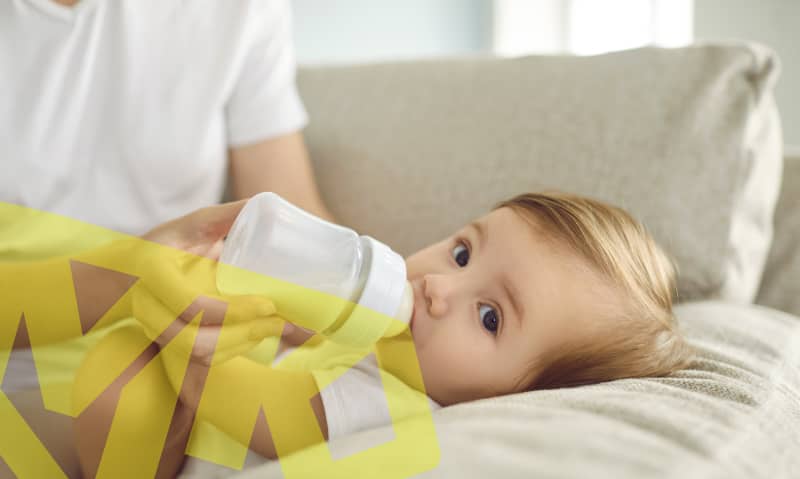What Is Baby Bottle Tooth Decay and How Do I Prevent It?

Tooth Decay Caused by Bottles and Pacifiers
As a parent with an infant or toddler, using bottles and pacifiers is a normal part of caring for your child. Bottles are undoubtedly essential for feeding, and pacifiers are useful soothing tools to keep your baby comfortable. But did you know these two objects could increase your baby’s risk of developing cavities?
We’re going to discuss baby bottle tooth decay and what you can do to keep your baby’s smile free from early childhood cavities.
Why Baby Teeth Develop Cavities
All teeth develop cavities the same way. Harmful bacteria in the mouth feed on sugars and starches and subsequently produce an enamel-eating acid as waste. The acid gradually wears away the tooth enamel, resulting in a cavity or dental caries.
Baby teeth are susceptible to decay as soon as they begin to erupt from the gums, meaning babies as young as six months are at risk for cavities. Cavities can also develop much more quickly in children as the enamel of baby teeth is thinner and more susceptible to damage.
Babies and toddlers develop tooth decay for similar reasons as adults: usually a combination of a high-sugar diet and poor oral hygiene. Infrequent brushing leads to plaque build-up, which only fosters further harmful bacteria growth in the mouth.
Another factor unique to infants is their mother’s oral health. Women who struggle with oral health due to chronic tooth decay or gum disease can transmit this bacteria to their infants.
How Bottles and Pacifiers Increase Risks of Cavities
So, now you know why cavities happen, but what does this have to do with bottles and pacifiers? There are two answers.
Firstly, bottles can increase your child’s risk of tooth decay because they increase the exposure time of their teeth to sugars in liquids. The longer your child’s teeth are exposed to sugars in diluted juice, formulas, or even natural sugar in breastmilk, the longer the time bacteria have to feed and produce cavity-causing acids.
Children who feed on a bottle throughout the day or go to bed with a bottle are at the highest risk of developing baby bottle tooth decay.
The secondary reason focuses on the use of pacifiers. Pacifiers can be soothing tools for infants, but you must properly clean pacifiers before use. Cleaning a dropped pacifier in your mouth or allowing siblings to share pacifiers dramatically increases the risks of transmitting harmful bacteria to your child.
Similarly, using a pacifier after a bottle feeding without cleaning the teeth first can have a similar effect on extending the amount of time of exposure.
Symptoms of Baby Bottle Tooth Decay
The most common signs of baby bottle tooth decay include:
- White, brown, or black spots on the upper front teeth
- Visible cavities or holes in the upper front teeth
- Children showing signs of tooth pain, perhaps with a mild fever
Cavities caused by improper use of bottles or pacifiers can happen anywhere in the mouth, but decay presenting primarily on the upper front teeth are a tell-tale sign.
Why Cavity Prevention Is Important in Early Childhood
Baby teeth are temporary, but their impact on your child’s growing smile is anything but superficial. Premature loss of baby teeth from decay can lead to future problems with speech development, alignment of emerging adult teeth, and increased risks of tooth decay in new adult teeth.
It isn’t the end of the world if your baby does need to have one or two teeth removed, but the underlying goal should always be to keep their smile as healthy as possible until their baby teeth shed naturally. Doing this ensures your child’s smile has a chance to develop with minimal alignment and bite issues and allows them to speak and eat well during this crucial early year in life.
Preventing Baby Bottle Tooth Decay
You can prevent baby bottle tooth decay by:
- Starting a twice-daily dental hygiene routine with your baby as soon as their first tooth erupts.
- Including fluoride kids’ oral care products as soon as a pediatric dentist recommends.
- Taking your child in for routine check-ups with a pediatric dentist no later than their first birthday.
- Limiting the amount of time your child has access to a bottle and always removing bottles before bedtime.
- Transitioning from a bottle to a sippy cup or similar cup as soon as your child can.
- Transitioning away from using a pacifier by age 3.
Your child’s pediatric dentist is indispensable in preventing early childhood caries. They will monitor the development of your child’s smile, keep the teeth free of plaque build-up, and guide you through weaning from reliance on a bottle or pacifier as appropriate based on your child’s age and behavioral needs.
Stop baby bottle tooth decay in its tracks today!
If you’re worried about baby bottle tooth decay or want to know more about cavity prevention, schedule an appointment at our Vancouver, WA, office today.